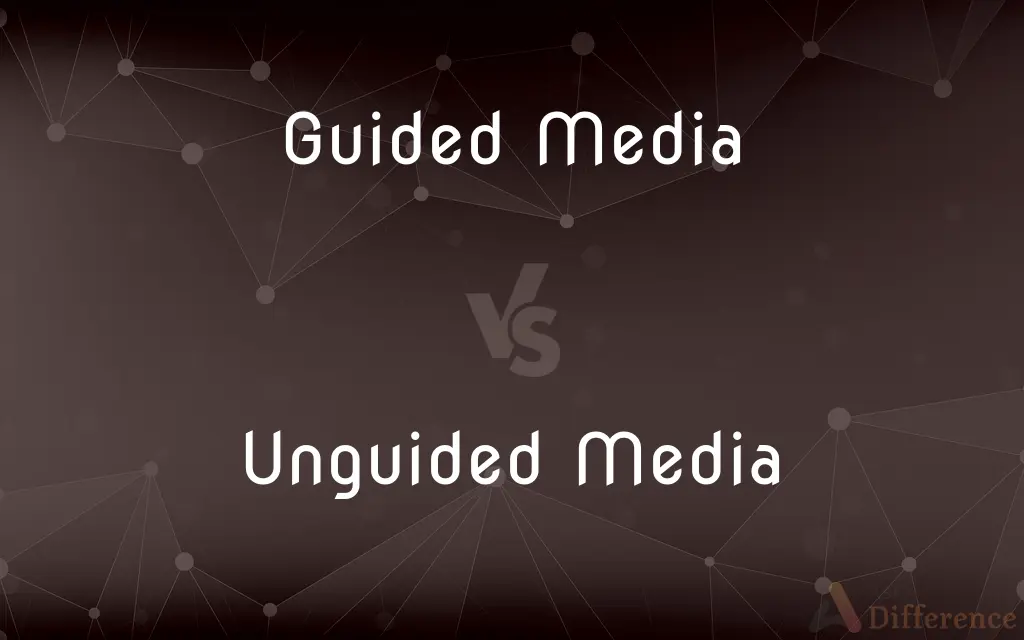Guided Media vs. Unguided Media — What's the Difference?
By Tayyaba Rehman — Published on January 10, 2024
Guided Media transmits data through physical means like cables. Unguided Media transmits data wirelessly, using methods like radio waves.

Difference Between Guided Media and Unguided Media
Table of Contents
ADVERTISEMENT
Key Differences
Guided Media, also known as bounded media, involves the use of physical pathways for data transmission. This includes various types of cables like twisted pair, coaxial, and fiber optic cables. These mediums guide the transmission signals along a specific path, which limits the spread of the signal outside the path. In contrast, Unguided Media, or unbounded media, refers to any medium that allows data transmission without the use of physical conduits. It relies on wireless methods, transmitting signals through air or vacuum, using radio waves, microwaves, or infrared signals.
The transmission range in Guided Media is often limited by the physical properties and length of the cable, which can restrict mobility and flexibility in terms of network setup. Unguided Media offers more flexibility and mobility as it doesn’t require physical connections, making it ideal for mobile communication and wide-area coverage. However, its range can be influenced by environmental factors and interference.
In terms of reliability and consistency, Guided Media generally provides a more stable and interference-free transmission, as the physical cables are less susceptible to external disruptions. Unguided Media, while convenient, can be more prone to interference from other wireless signals, physical obstacles, and weather conditions, potentially affecting the quality and reliability of the transmission.
Guided Media often offers higher bandwidth and data transfer rates due to the physical properties of the cables, especially in the case of fiber optic technology. Unguided Media, while having made significant advancements in terms of speed and bandwidth with technologies like 5G, generally has limitations compared to wired connections, particularly over longer distances.
Security is another aspect where Guided Media typically has an advantage, as physical access to the network is required for interception. Unguided Media, transmitting signals openly through the air, is more susceptible to eavesdropping and requires more robust encryption and security protocols to ensure data privacy.
ADVERTISEMENT
Comparison Chart
Medium
Physical cables (twisted pair, coaxial, fiber optic).
Wireless (radio waves, microwaves, infrared).
Transmission Range
Limited by cable length; less mobility.
Greater flexibility and mobility; range affected by environment.
Reliability
More stable and less prone to external interference.
Susceptible to interference and environmental factors.
Bandwidth and Speed
Generally higher bandwidth and faster speeds.
Improving but typically less than wired connections.
Security
More secure, physical access needed for interception.
More vulnerable to eavesdropping, requires strong encryption.
Compare with Definitions
Guided Media
It includes twisted pair, coaxial, and fiber optic cables.
Fiber optic cables provide high-speed internet through Guided Media.
Unguided Media
Uses methods like radio waves, microwaves, or infrared.
Cell phone networks employ Unguided Media through radio waves.
Guided Media
Guided Media involves data transmission through physical cables.
Ethernet cables in an office network are a form of Guided Media.
Unguided Media
Offers mobility and flexibility in data transmission.
Unguided Media allows for internet connectivity in outdoor events.
Guided Media
Offers reliable, interference-resistant transmission.
A stable cable connection in Guided Media ensures consistent data transfer.
Unguided Media
Unguided Media transmits data wirelessly.
Wi-Fi networks in homes and cafes utilize Unguided Media for internet access.
Guided Media
Typically used for stable, fixed-location network setups.
Data centers rely on Guided Media for secure and fast connections.
Unguided Media
Prone to interference and environmental impacts.
Wireless signals in Unguided Media can be disrupted by physical obstacles.
Guided Media
Provides higher bandwidth and faster transmission speeds.
High-definition video streaming is efficiently supported by Guided Media.
Unguided Media
Requires robust security measures due to open-air transmission.
Encryption in Wi-Fi routers is crucial for securing Unguided Media communications.
Common Curiosities
How does Guided Media provide security?
By requiring physical access to the network for data interception.
What is Guided Media?
Guided Media refers to data transmission through physical cables like fiber optic, coaxial, or twisted pair.
Where is Guided Media most commonly used?
In fixed, stable network setups such as office buildings and data centers.
What are the advantages of Unguided Media?
It offers mobility, flexibility, and is suitable for mobile communication.
Is Unguided Media more susceptible to eavesdropping?
Yes, due to its open-air transmission, it requires strong encryption for security.
Are there speed differences between Guided and Unguided Media?
Yes, Guided Media typically offers faster speeds and higher bandwidth.
Can Unguided Media be used for long-distance transmission?
It can, but it's often less reliable over long distances compared to Guided Media.
Can Guided Media be used for outdoor networking?
It's less common due to mobility and installation constraints.
What is Unguided Media?
Unguided Media involves wireless transmission of data using methods like radio waves.
What makes Guided Media reliable?
Its physical infrastructure is less prone to external interference.
Which is better for home use, Guided or Unguided Media?
It depends on specific needs; Unguided Media offers more flexibility, while Guided Media can provide faster, more stable connections.
Are there cost differences between Guided and Unguided Media?
Yes, the cost of infrastructure and maintenance can vary significantly.
How does weather impact Unguided Media?
Severe weather can disrupt wireless signals in Unguided Media.
What environmental factors affect Unguided Media?
Factors like physical obstacles, weather conditions, and other wireless signals.
Is installation of Guided Media more complex?
It can be, due to the need for physical cable infrastructure.
Share Your Discovery

Previous Comparison
Prop Root vs. Stilt Root
Next Comparison
Molar Mass vs. Atomic MassAuthor Spotlight
Written by
Tayyaba RehmanTayyaba Rehman is a distinguished writer, currently serving as a primary contributor to askdifference.com. As a researcher in semantics and etymology, Tayyaba's passion for the complexity of languages and their distinctions has found a perfect home on the platform. Tayyaba delves into the intricacies of language, distinguishing between commonly confused words and phrases, thereby providing clarity for readers worldwide.












































